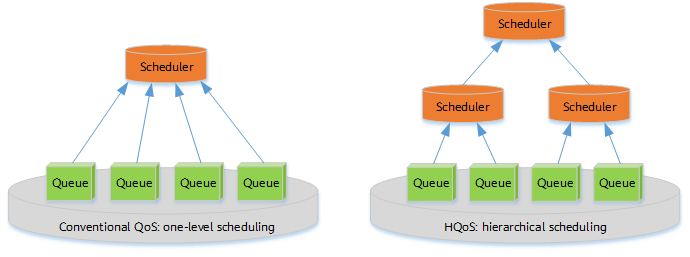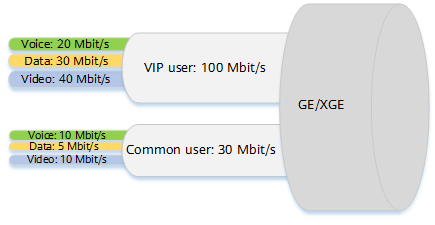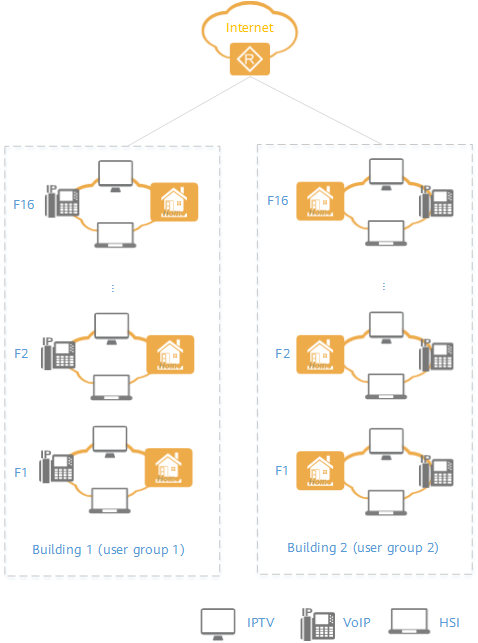What Is Hierarchical Quality of Service (HQoS)?
Hierarchical Quality of Service (HQoS) uses a hierarchical queue scheduling mechanism to ensure the bandwidth of different services for users in the Differentiated Services (DiffServ) model. Conventional QoS performs one-level traffic scheduling. A single port can differentiate only services but not users. HQoS implements hierarchical scheduling based on multiple levels of queues, and differentiates traffic of different users and services to provide refined QoS guarantee.
What Is the Difference Between HQoS and QoS?
HQoS is not a QoS solution independent of the conventional QoS using the DiffServ model. It adds hierarchical scheduling based on conventional QoS to implement refined traffic management.

Scheduling models of conventional QoS and HQoS
In the QoS DiffServ model, packets enter different queues based on the mappings between their priorities and the internal priorities of the device. The scheduler determines the sequence of sending packets in different queues based on the scheduling algorithm (such as priority-based SP scheduling and weight-based DRR/WRR/WDRR/WFQ scheduling).
The following uses two examples to describe the differences between conventional QoS and HQoS.
Conventional QoS: One-Level Scheduling Mechanism
Assume that packets of data, voice, and video services enter different queues. These queues use the SP scheduling algorithm and are classified into high-priority queues, medium-priority queues, and low-priority queues. When packets leave a queue, they are scheduled based on their priorities. Voice packets are sent first, followed by data packets, and then video packets.

One-level scheduling of conventional QoS
Conventional QoS schedules traffic on a per-port basis, in which a single port can differentiate priorities of services but not users. As such, multiple types of traffic with the same priority but from different users are placed into the same port queue (PQ), where they compete for resources. This means that differentiated services cannot be offered to different users.
HQoS: Hierarchical Scheduling Mechanism (Two-Level Scheduling as an Example)
Assume that there are common users and VIP users. Both types of users have data, voice, and video services. HQoS provides two-level scheduling: user-based scheduling and service-based scheduling. User-based scheduling ensures that packets of VIP users are preferentially sent. Service-based scheduling is performed for different services of each user to ensure that important services are preferentially processed, which is similar to one-level scheduling of conventional QoS.

Two-level scheduling of HQoS
After HQoS is applied to a port, traffic management can be abstracted, as shown in the following figure. User bandwidth is allocated to different users based on the port bandwidth, and then service bandwidth is allocated to different services based on each user.

HQoS traffic management
HQoS differentiates both services and users through hierarchical scheduling, ensures that services of VIP users and high-priority services are preferentially processed, and allocates guaranteed bandwidth to different services and users, implementing more refined traffic management than conventional QoS.
HQoS Application
When conventional QoS cannot meet network traffic management requirements, HQoS can be used to provide differentiated QoS guarantee for key users and services, improving user experience. Ensure that the network device that processes traffic must support HQoS.
HQoS is widely used, for example, in enterprise campus networks to meet diversified service requirements of campus users, or on ISP edge devices to meet the bandwidth requirements of access users with different service levels. The HQoS traffic design model varies according to industries and application scenarios. Therefore, it needs to be designed and deployed based on actual network requirements.
The following uses home broadband as an example to describe the application of HQoS.
A carrier launches a home broadband package in a residential compound. The bandwidth is 100 Mbit/s, including VoIP, IPTV, and high speed Internet (HSI) services. With this package, each family can use VoIP to make calls, use set-top boxes (STBs) to watch TV programs, and use PCs, tablets, and mobile phones to access the Internet.
HQoS can be deployed as follows:
- Classify the three types of services, and control traffic scheduling and bandwidth allocation among these services.
- Each family is considered as a user. Allocate bandwidth to each user and configure rate limits to ensure that the bandwidth of each user is 100 Mbit/s.
- In this example, all households in each building can be configured as a user group (three-level scheduling is implemented in this scenario). The total bandwidth of the user group is the total bandwidth of 16 households, which can share the bandwidth.
HQoS ensures bandwidth allocation for various services in a household and bandwidth allocation between households. In addition, HQoS implements bandwidth sharing.

HQoS application (home broadband)
HQoS Scheduling Structure
HQoS hierarchical scheduling typically uses a tree scheduling structure. Two levels of schedulers can be used to implement the three-layer scheduling structure (for example, service-user two-level scheduling). Three levels of schedulers can be used to implement the four-layer scheduling structure (for example, on the basis of service-user two-level scheduling, user group-based scheduling can be added). In addition, one more level of scheduling can be added to implement the five-layer scheduling structure. (For example, if multiple user groups access the network through sub-interfaces, on the basis of service-user-user group three-level scheduling, scheduling based on sub-interfaces for access of user groups can be added to allocate guaranteed bandwidth to each user group and implement bandwidth sharing among user groups.)
The HQoS scheduling structure is closely related to the hardware support capability. Different vendors and chips may support different scheduling levels, scheduling algorithms, and configuration models.

HQoS scheduling structures
- Author: Qiu Beibei
- Updated on: 2024-02-27
- Views: 20074
- Average rating:






